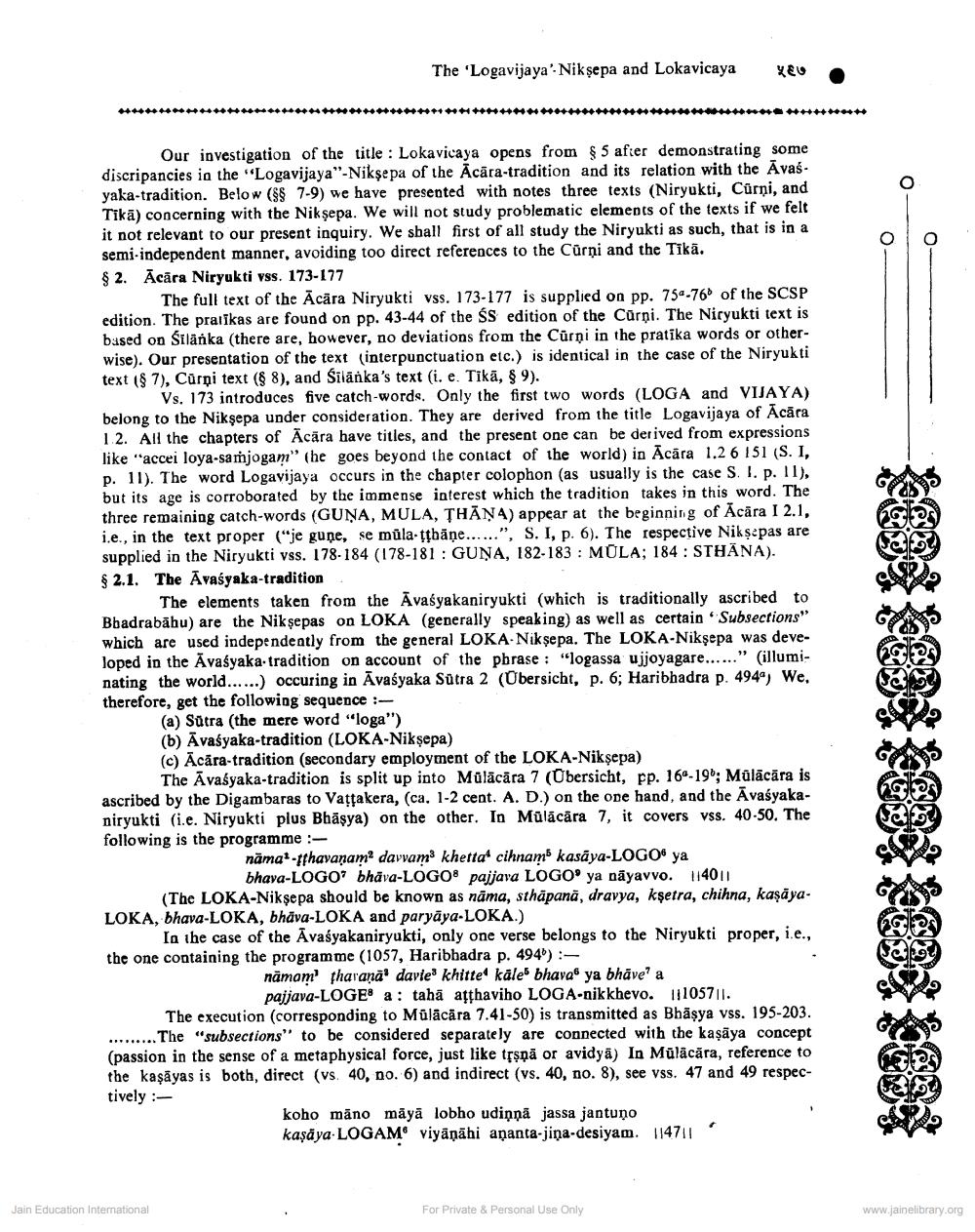________________
The 'Logavijaya Niksepa and Lokavicaya
Our investigation of the title: Lokavicaya opens from § 5 after demonstrating some discripancies in the "Logavijaya"-Nikşepa of the Acara-tradition and its relation with the Avaśyaka-tradition. Below (§§ 7-9) we have presented with notes three texts (Niryukti, Cürni, and Tikā) concerning with the Nikşepa. We will not study problematic elements of the texts if we felt it not relevant to our present inquiry. We shall first of all study the Niryukti as such, that is in a semi-independent manner, avoiding too direct references to the Curni and the Tīkā.
§ 2. Acara Niryukti vss. 173-177
The full text of the Acara Niryukti vss. 173-177 is supplied on pp. 75-76 of the SCSP edition. The pratīkas are found on pp. 43-44 of the SS edition of the Cürņi. The Niryukti text is based on Silänka (there are, however, no deviations from the Curni in the pratika words or otherwise). Our presentation of the text (interpunctuation etc.) is identical in the case of the Niryukti text (§ 7), Cūrņi text (§ 8), and Silänka's text (i. e. Tikā, § 9).
RTO
Vs. 173 introduces five catch-words. Only the first two words (LOGA and VIJAYA) belong to the Nikşepa under consideration. They are derived from the title Logavijaya of Acara 1.2. All the chapters of Acara have titles, and the present one can be derived from expressions like "accei loya-samjogam" (he goes beyond the contact of the world) in Acara 1.2 6 151 (S. I, p. 11). The word Logavijaya occurs in the chapter colophon (as usually is the case S. I. p. 11), but its age is corroborated by the immense interest which the tradition takes in this word. The three remaining catch-words (GUNA, MULA, THANA) appear at the beginning of Acara I 2.1, i.e., in the text proper ("je gune, se mula-tthäne......", S. I, p. 6). The respective Nikṣepas are supplied in the Niryukti vss. 178-184 (178-181: GUNA, 182-183: MÜLA; 184: STHANA). §2.1. The Avasyaka-tradition
The elements taken from the Avaśyakaniryukti (which is traditionally ascribed to Bhadrabahu) are the Nikṣepas on LOKA (generally speaking) as well as certain Subsections" which are used independently from the general LOKA-Nikṣepa. The LOKA-Nikşepa was developed in the Avaśyaka-tradition on account of the phrase: "logassa ujjoyagare......" (illuminating the world......) occuring in Avaśyaka Sütra 2 (Übersicht, p. 6; Haribhadra p. 494) We. therefore, get the following sequence :
(a) Sütra (the mere word "loga")
(b) Avasyaka-tradition (LOKA-Nikṣepa)
(c) Acara-tradition (secondary employment of the LOKA-Niksepa)
The Avasyaka-tradition is split up into Mülacăra 7 (Übersicht, pp. 16-19; Mülācāra is ascribed by the Digambaras to Vaṭṭakera, (ca. 1-2 cent. A. D.) on the one hand, and the Avaśyakaniryukti (i.e. Niryukti plus Bhāṣya) on the other. In Mülācāra 7, it covers vss. 40-50. The following is the programme :
nāma1-tthavanam davvam khetta cihnam kasaya-LOGO" ya bhava-LOGO" bhava-LOGO pajjava LOGO' ya nayavvo. 1140||
(The LOKA-Nikşepa should be known as nāma, sthapana, dravya, kṣetra, chihna, kaṣāyaLOKA, bhava-LOKA, bhava-LOKA and paryaya-LOKA.)
In the case of the Avaśyakaniryukti, only one verse belongs to the Niryukti proper, i.e.,
the one containing the programme (1057, Haribhadra p. 494') :
Jain Education International
nāmam' thavana' davies khitte kale bhava ya bhāve" a
pajjava-LOGE a: taha atthaviho LOGA-nikkhevo. 11105711.
The execution (corresponding to Mülācāra 7.41-50) is transmitted as Bhāṣya vss. 195-203. .........The "subsections" to be considered separately are connected with the kaşaya concept (passion in the sense of a metaphysical force, just like tṛṣṇā or avidya) In Müläcăra, reference to the kaşayas is both, direct (vs. 40, no. 6) and indirect (vs. 40, no. 8), see vss. 47 and 49 respectively :
koho māno māyā lobho udiņņā jassa jantuņo kaşaya LOGAM viyänähi ananta-jina-desiyam. ||47||
For Private & Personal Use Only
***
www.jainelibrary.org




